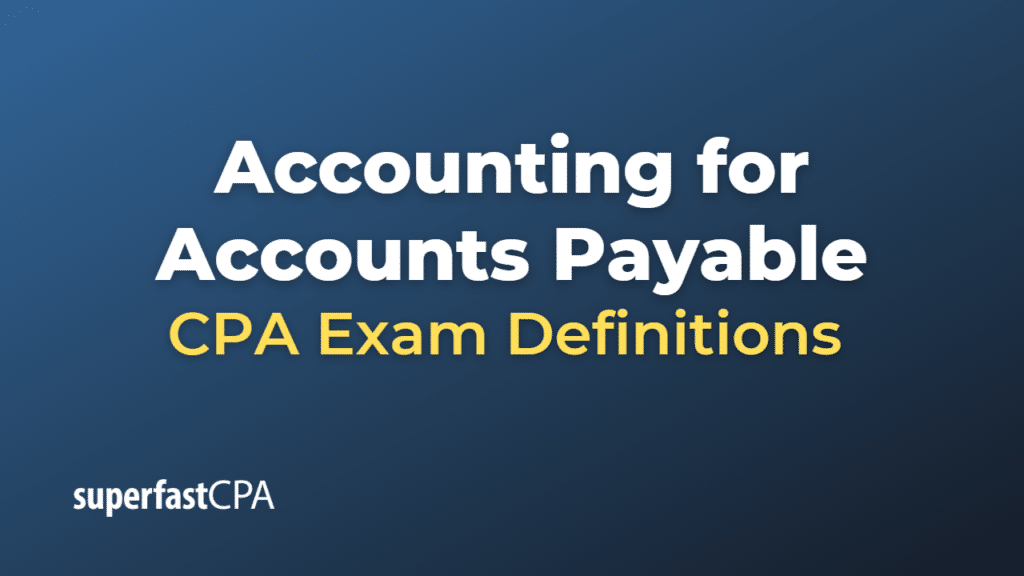Accounting for Accounts Payable
Accounting for accounts payable involves recording and managing the amounts owed by a business to its suppliers, vendors, or other creditors for goods or services purchased on credit. Accounts payable is a liability account and represents short-term financial obligations that the business needs to fulfill, typically within a specified period (e.g., 30, 60, or 90 days).
The process of accounting for accounts payable typically involves the following steps:
Step 1:
Recording the initial transaction: When a business purchases goods or services on credit, it records the transaction by increasing the accounts payable balance and the corresponding expense or asset account. The journal entry for this transaction would look like:
| Date | Account | Debit | Credit |
|---|---|---|---|
| 03-23-2023 | Inventory (or Expense) | $X | |
| Accounts Payable | $X |
Step 2:
Recognizing discounts or returns: If the business receives a discount for early payment or returns some goods to the supplier, it would adjust the accounts payable balance accordingly. The journal entry for a discount or return would look like:
| Date | Account | Debit | Credit |
|---|---|---|---|
| 03-28-2023 | Accounts Payable | $Y | |
| Inventory (or Expense) | $Y |
Step 3:
Paying the outstanding balance: When the business pays its outstanding payable balance, it records the payment by decreasing the accounts payable balance and the cash (or another form of payment) account. The journal entry for the payment would look like:
| Date | Account | Debit | Credit |
|---|---|---|---|
| 03-31-2023 | Accounts Payable | $Z | |
| Cash | $Z |
Step 4:
Managing and reconciling accounts payable: To ensure accurate financial reporting, businesses must regularly monitor their accounts payable balances, match them with supplier invoices and purchase orders, and resolve any discrepancies. This process, known as accounts payable reconciliation, helps businesses maintain accurate financial records and manage their cash flows effectively.
By properly accounting for accounts payable, businesses can track their outstanding obligations, manage their cash flows, and ensure accurate financial reporting. Moreover, maintaining good relationships with suppliers and vendors by paying their invoices on time can lead to better credit terms, discounts, and more favorable business opportunities.
Example of an Accounting for Accounts Payable
Let’s consider a fictional example of a small electronics store, “Gadget Hub,” to illustrate the process of accounting for accounts payable.
Gadget Hub purchases 10 laptops from a supplier for $1,000 each on credit, with a payment due in 30 days. Here’s how Gadget Hub would account for the accounts payable:
Step 1:
Recording the initial transaction: When Gadget Hub receives the laptops, it records the transaction as an increase in inventory (an asset) and an increase in accounts payable (a liability).
| Date | Account | Debit | Credit |
|---|---|---|---|
| 03-23-2023 | Inventory | $10,000 | |
| Accounts Payable | $10,000 |
Step 2:
Recognizing a discount: The supplier offers Gadget Hub a 2% discount for early payment within 10 days. Gadget Hub decides to take advantage of the discount and pays the supplier within the discount period. The discount amount is $200 (2% of $10,000).
| Date | Account | Debit | Credit |
|---|---|---|---|
| 03-27-2023 | Accounts Payable | $200 | |
| Inventory | $200 |
Step 3:
Paying the outstanding balance: Gadget Hub pays the remaining balance of $9,800 ($10,000 – $200) to the supplier within the 10-day discount period.
| Date | Account | Debit | Credit |
|---|---|---|---|
| 03-27-2023 | Accounts Payable | $9,800 | |
| Cash | $9,800 |
Step 4:
Managing and reconciling accounts payable: Throughout this process, Gadget Hub should maintain accurate records of its accounts payable, match them with the supplier’s invoice, and resolve any discrepancies. By regularly reconciling its accounts payable, Gadget Hub can ensure accurate financial reporting and effective cash flow management.
In this example, Gadget Hub properly accounted for its accounts payable by recording the initial transaction, recognizing the discount, and paying the outstanding balance. By doing so, the store managed its financial obligations, maintained accurate financial records, and took advantage of the early payment discount offered by the supplier.













